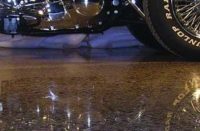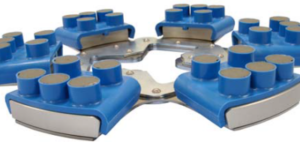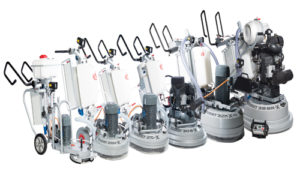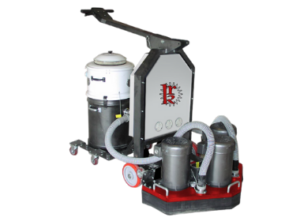
There’s a lot happening in the grinder and polisher market today, and much of it is good news for anyone looking to incorporate finishing and refinishing into a business mix.
Whether your preferred clients are homeowners installing a new concrete floor, or upgrading an old one, or you’re looking for commercial projects — think anything from schools to office buildings to airport terminals — to finish and maintain, there’s equipment out there that will fit your needs.
Still, it’s not an easy decision. Over the past 20 years, the market has grown to include a variety of heads, electric and propane power systems for both the grinders and vacuums, and a host of tooling.
The bottom line: know just what market you’re hoping to serve, do your research and then ask lots and lots of questions.

Know your market
Many people get into the concrete industry with little more than hand tools, a strong back, sturdy knees and a willingness to work. A grinder can represent a large capital investment, whether you’re looking at hand-controlled models for four figures or ride-on versions that can sell for upwards of $100,000, depending on the size.
With that said, it’s important to know just what you need before you write that check. And, to do that, you have to know your market.
First off, what do you want to do? David Padgett, CEO of Concrete Polishing Solutions in Norris, Tennessee, and chairman of the International Polished Concrete Institute, says the right machine can both grind and polish.
“However, you have to remember that a grinder is more for surface preparation and concrete repair,” Padgett says. “Defining a polisher gets vague because anybody that has a floor buffer has a polisher. It can be anything from a buffer to a large planetary machine.”
Still, polishing is probably the smaller portion of most people’s work, according to Jamie Krueger, product manager for surface prep and polishing equipment for the Olathe, Kansas-based Husqvarna Construction Products Americas. He says in terms of square footage, many people find they do more grinding, whether it involves removing glues, mastics and coatings, or prepping a surface.
Once you know what sort of work you’re going to be doing, it’s easier to begin narrowing your choices. Smaller jobs may need a walk-behind machine in the 21- to-40-inch range, while larger ones may require a ride-on machine that can weigh thousands of pounds.

Obviously, a larger grinder will cover more square feet in a day.
“Larger grinders also can’t get into every location,” says Krueger. “Interior residential doors may only be 28 inches in width, so if your grinder is 32 inches, that’s a problem. On the flip side, if a contractor is bidding on a 40,000-square-foot school job, doing the work with a 21-inch grinder wouldn’t be efficient. That’s why we distribute single- and three-phase machines from 10 to 32 inches to cover the full range of applications.”
Then, there’s the issue of wall edges and corners. Ralph Newbigin, COO of Burnaby, British Columbia-based WerkMaster, says that company’s machines can get within 1/8 inch of any wall.
“Obviously, you can’t get quite into a corner. You always have a small arc left, but we’re talking about maybe 3/4 inch,” he says. “We recommend a fine tool or reciprocating tool to get into this last part.”
Still another important consideration is the weight of a machine. CPS’s Padgett notes that a truly heavyweight grinding machine may require a loading dock, a box truck and a licensed commercial driver to get it from job site to job site. Even a 3,000-pound machine can put a strain on a pickup lift gate.
However, there are also smaller machines on the market. Josh Jones, president of Substrate Technology Inc. in Morris, Illinois, says his company is introducing a line of smaller grinding machines, and weight was an important consideration.
“Our smallest machine until now weighed 850 pounds and is a big, heavy machine,” he says. “Our newest offering, which we call the Junior, weighs in at 400 pounds and breaks into two pieces. Two people can get it in and out of a truck, onto a cart, down some stairs and put it back together again in 10 minutes.”

Power up
Still another consideration is the power supply. Many manufacturers make models that run on propane, while others are electric. Both have their advantages and disadvantages.
At Diamatic USA in San Diego, Steve Klugherz says that the company is back-ordered on its new single-phase electric model that sells for under $10,000, and is excited by its electric burnisher line for polishing to the point of phasing out its propane models.
“The electric allows people to rejuvenate concrete floors with other workers in there and not worry about fumes contaminating vegetables or cheeses or killing pets with carbon monoxide,” he says. “A lot of people have bought propane to do their extra work, but I’d say a large percentage of those guys aren’t handling the propane machines correctly.”
That may include not wearing a personal monitoring device for carbon monoxide, incorrectly maintaining the machine or ignoring the carbon monoxide alert signal.
STI’s Jones is quick to acknowledge that people aren’t always good about maintaining their equipment, and propane-powered machines require maintenance much more frequently. However, he says propane is safe for indoor use.
“Our products have been tested to conform to the state mandate in California, which means all the other states accept it because California is the most-strict,” Jones says. “You have to have proper air flow, but the machines are also fitted with carbon monoxide sensors with active interrupts. If you have an unsafe amount of carbon monoxide, the machine will run for 10 seconds and then shut down.”
The big advantage with a propane-powered machine is that it frees up the operator to move around on the job.
“That’s particularly true on larger jobs, where your power may be hundreds of feet away from where you’re going to be grinding,” says WerkMaster’s Newbigin. “A propane machine can go where the machine needs to go, you don’t need to take a generator, and you don’t have to wait for an electrician to come along and attach a pigtail to the power board.”
Not only does propane eliminate the cords for the grinder itself, but also for the vacuum, which is a must with dry grinding and polishing. Diamatic’s Klugherz estimates 99 percent of work on concrete can be done dry.
STI’s Jones says the most important aspect of the vacuum is that it’s sized for the machine being used, and then properly cared for.
“There should be no visible emissions coming from under the machine,” Jones says. “If you don’t maintain the vacuum it doesn’t matter what you’re using.”
‘Best opportunity’
If you’re confident you have a market for grinding and polishing services, buying a machine and tooling isn’t any different from any other capital investment. Just be sure to ask lots and lots of questions so you don’t end up buying a machine that won’t meet your needs from a company that ignores you after the check clears.
Jones suggests starting with discussion boards and industry forums. “But remember, that’s not necessarily qualified knowledge.”
From there, it’s time to look at “everything on the market,” says Newbigin. And, if a particular manufacturer catches your eye, look at what’s online, including videos. Also, don’t hesitate to ask for references.
Ask about the manufacturer’s training programs, support and warranty. And get a referral to the manufacturer’s nearest dealer, as well.
“Even though they’re the middleman, they’re going to be close to your location, and they’ll be the one to help you if you have a problem,” says STI’s Jones. “Put the dealer to the test: have him come out and do a demo. And, if they won’t do that, go on to the next guy.”
Perhaps one of the hardest questions to answer is where do you want you and your company to be in three and five years. If you have visions of growing your business (and you probably do), then look at a company that has a deep product line, say both Diamatic’s Klugherz and Husqvarna’s Kruger.
“If you plan to stay in business, look for the highest quality machines with the deepest line extension,” says Klugherz. “You might want an inexpensive first machine, but you need a reliable piece of equipment to build a company around.”
“Remember: it comes down to what’s the best machine for you,” says Newbigin. “It’s all about leaving your customer incredibly satisfied. You want the machine you think will give you the best opportunity to delight your customer at the most cost-effective price.”
www.diamaticusa.com
www.go2cps.com
www.husqvarnacp.com
www.substratetechnology.com
www.werkmaster.com















